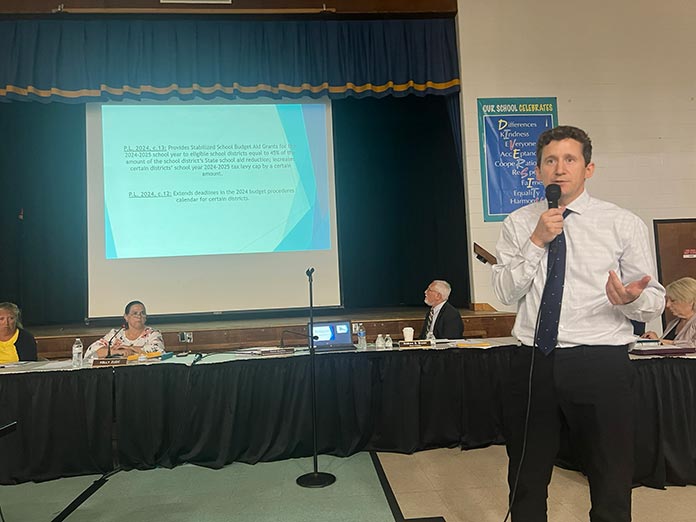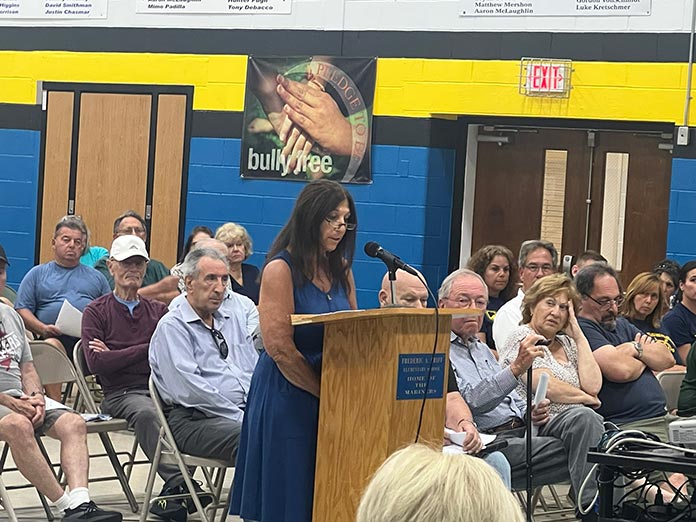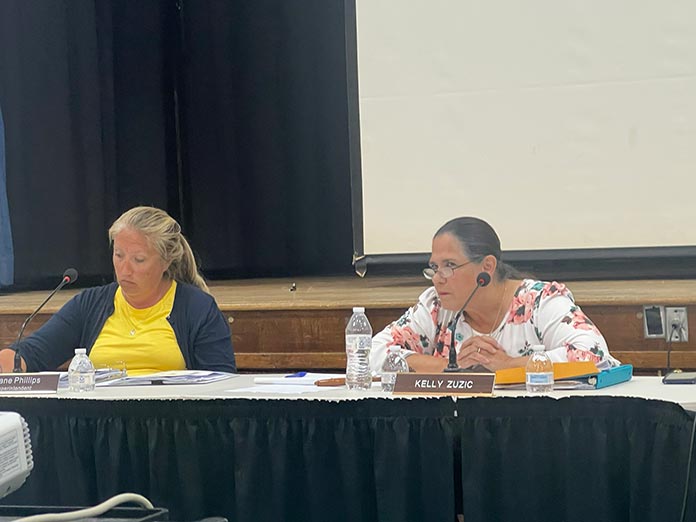
WARETOWN – The Ocean Township School Board passed a controversial budget with a 3-2 vote at its final hearing. The budget includes a 9.9 percent tax levy increase, the maximum allowed for struggling districts under a new state law.
The vote flipped from the tentative budget proposal in June, when Board President Kelly Zuzic, Vice President Brian Tart, and Patricia Fuchs voted yes, while Justin Pimm and Marie Leaming voted no. Notably, Fuchs and Pimm reversed their votes in the final hearing.
Pimm did not explain his change of heart, whereas Fuchs delivered a comprehensive statement outlining her concerns about the proposed 9.9 percent tax levy increase.
“The Board of Education’s primary goal is to provide quality education,” Fuchs said. “The 9.9 percent tax levy increase provides immediate relief by generating additional revenue. It doesn’t address the underlying financial challenges faced by our district at the current time and in the future.”
Leaming said that she would have voted for the increase if she had to make the decision for her household. However, she recognized her obligation to both the students and taxpayers alike. Although people have blamed the current governor, Leaming reminded the public that cuts to school funding also date back to the prior administration.

The Public Speaks Out
Public opposition to the budget had been growing since its tentative introduction on June 10. Residents, particularly from the Greenbriar retirement community, packed the board meetings to express their concerns. More than the usual, two or three onlookers were at the June 10 meeting, the July 2 workshop, and the public hearing on July 8.
The board has long been criticized for lacking transparency, particularly for not broadcasting its meetings or making them available for public review. At the final budget hearing, an audience member took matters into their own hands and livestreamed the proceedings.
Lizabeth Carroll, a Greenbriar resident, questioned the student-teacher ratio and overall spending, emphasizing the financial hardships many in the community face. She said she’d gone to school in a classroom filled with 56 students and suggested adjusting the 22-1 student to teacher ratio. She also expressed concerns about the school’s low achievement scores.
Joan Tredy, a senior and long-time resident, said that some have pointed out that seniors can take advantage of a tax freeze that is available to them. However, they must still find the funds to pay the tax upfront.
“It’s not just the seniors,” Tredy added. “Young families are finding it hard to make ends meet, and this tax increase will only add to their burden.”
The Waretown Elementary School’s guidance counselor advocated for the increase. Lauren Eberenz, a lifelong resident and parent of a student in the district, stressed the importance of maintaining quality education while addressing the funding shortfall.
“We need to recover some of what’s been lost (in state aid),” Eberenz said. “We are not asking for a swimming pool – just the essentials needed to operate within state guidelines and provide students with a quality education.”
“Those of us who are left cannot possibly work any harder or give any more of ourselves,” Eberenz added. “We are working at an unsustainable level in an attempt to provide the children with the education they deserve.”
Deputy Mayor Ben LoParo, speaking as a taxpayer, urged the board to find a compromise between the initial 3.6 percent increase and the proposed 9.9 percent. LoParo previously served on both the local school board and Southern Regional’s Board of Education.
“I love our teachers and schools, but there has to be common ground,” LoParo said. “Strategic planning is crucial, and we need to find a balance that doesn’t overly burden taxpayers.”
Diane MacKenzie, who now lives in Forked River, said she and her husband taught and were part of the school’s administrative team for more than thirty years. She encouraged the school board to pass the entire 9.9 percent increase.
“We understand the need to be fiscally responsible, but at the same time, our students deserve a thorough and efficient education with small class sizes, fabulous programs, excellent staff, and other resources that could potentially be cut without this increase in the taxes,” said MacKenzie. “This school district did not go to the allowable cap for many years to appease and help the taxpayers.”
A couple of parents spoke out against what they view as the threat of regionalizing the district to make ends meet. They cited fears of small children being bussed to other towns and a loss of local control.
As far back as 2019, Ocean Township Schools were identified as one of 275 districts that should consider a merger with other school systems. The Township Committee recently asked for a study to determine the feasibility. However, Zuzic dismissed the idea of the study, saying the study itself could cost between $100,000 – $150,000.

Financial Challenges
Business Administrator Kevin Byrnes highlighted the district’s financial challenges with a presentation at the public hearing. He indicated that local schools have lost $5.4 million in state aid over the last seven years.
The district operates two schools within the community and is a sending district to Southern Regional High School. Their annual budget is nearly $20 million to educate approximately 900 students.
In addition to losing state aid, the district has incurred significant cost increases. Some of these increases happened after the budget was made public in April. Since then, the need for four out of town district placements for special education students surfaced. This amounts to approximately an average of $80,000 per placement and roughly $60,000 in transportation costs for a total of $410,00 in added costs.
“In addition…we also have additional personnel costs that have arisen,” said Byrnes. “This includes the need to hire an additional special education teacher. We also have to be in compliance with our ESL student offerings.”
The district also faces a $600,000 tuition adjustment to send students to Southern Regional Middle School and High School. This adjustment is due to a large graduating sixth-grade class entering the Southern Regional School District and a small graduating senior class leaving Southern Regional.
Byrnes said that surplus has been used to cover some expenses but expressed concerns that it will be depleted. He also wants to have money on hand for future school years, as there is no way of predicting any future state aid reductions. He said the state has talked about limiting the percentage of decreases in the future and hopes that comes to fruition.
Previously, the district indicated that the increased tax levy will “help maintain current class sizes and provide academic support for struggling learners and meet state requirements for multilingual and foreign language instruction, as well as inflationary costs in current and future budget cycles.”
The increase in tax revenue is anticipated to help with future funding issues if more state aid is withdrawn from the district.
Impact On Taxpayers
Ocean Township Schools is among several districts taking advantage of the ability to bypass the 2 percent tax levy cap, jumping to 9.9 percent to address financial struggles. However, the local district has some distinguishing factors.
First, in 2022, voters passed a referendum for $840,000, allowing the district to exceed the 2 percent cap to retain teachers and maintain small classroom sizes. Although Board President Kelly Zuzic asserted there had been no guarantee this would be a one-time event, the minutes of the June 10 meeting quoted the board’s previous president and vice president as reminding them of their commitment.
Byrnes provided examples to illustrate the impact of the new tax rate. For a home assessed at $350,000 in 2024, the annual tax increase would be $227.44, translating to $18.95 monthly. At the higher end, a home reassessed at $600,000 would see an annual increase of $389.90, or $32.49 per month.
The town recently underwent a reassessment, meaning that all properties were brought closer in line to what the going rate would be for sales.
This significantly altered the school property tax rate. The local district’s new rate is now 0.672, the lowest in the area, compared to last year’s rate of 1.038, according to Ocean County records.







